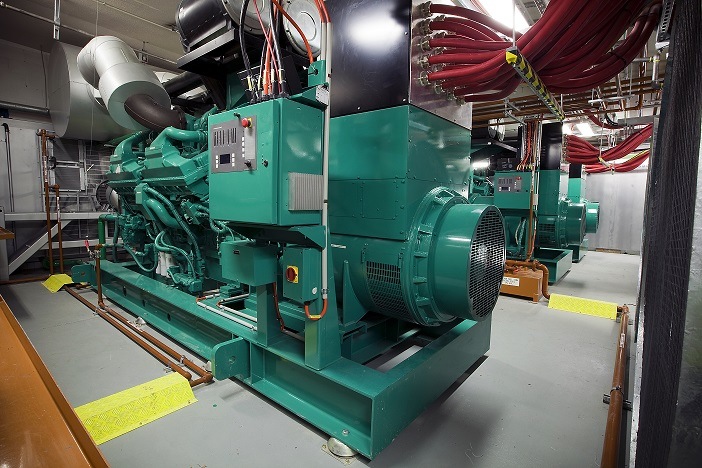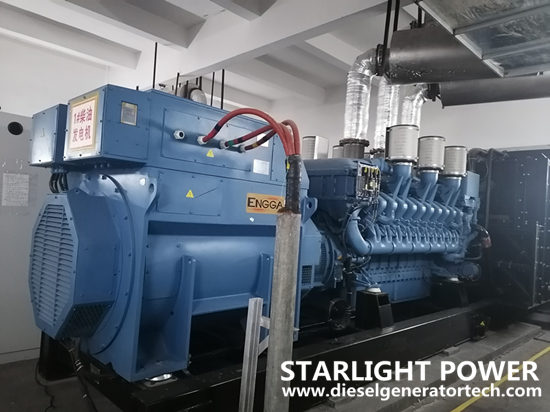Yes, generators can overheat. Overheating can result from prolonged use or insufficient maintenance.
Generators are vital for providing backup power during outages. They ensure continuity in homes and businesses, especially during emergencies. Overheating poses a significant risk to the generator’s performance and longevity. Several factors contribute to overheating, including extended usage, insufficient ventilation, and lack of regular maintenance.
Neglecting these aspects can lead to severe damage and costly repairs. It’s essential to monitor your generator’s temperature and perform routine checks. Proper maintenance and timely servicing can prevent overheating issues. Ensure the generator is placed in a well-ventilated area. Investing time in upkeep can extend the life of your generator, keeping it reliable when needed most.

Credit: mvdirona.com
Causes Of Overheating
Generators can overheat due to various reasons. Understanding these causes can help you prevent damage. Below are the main reasons why generators overheat.
Lack Of Ventilation
Lack of ventilation is a common reason for generator overheating. Generators need proper airflow. Without it, heat cannot escape. This builds up heat inside the generator. Make sure the generator has enough space around it. Keep it away from walls and objects. Clean the air vents regularly. Blocked vents lead to poor airflow. This can cause overheating quickly.
Overloading The Generator
Overloading the generator is another major cause of overheating. Every generator has a maximum capacity. Exceeding this limit makes the generator work harder. This generates extra heat. Check the generator’s capacity before use. Do not plug in too many devices. Use a power strip with a surge protector. This helps manage the load effectively.

Credit: www.engineeringworldchannel.com
Signs Of Overheating
Generators can overheat. Identifying the signs early prevents damage. Overheating can harm the generator and pose safety risks.
Unusual Noises
Generators usually hum quietly. Loud or strange noises signal problems. Listen for knocking, grinding, or hissing sounds. These noises might mean a part is failing.
Common Causes:
- Loose components
- Damaged bearings
- Fan issues
Burning Smell
A burning smell from your generator is a bad sign. This smell often means overheating. It could also mean electrical issues.
| Cause | Possible Issue |
|---|---|
| Burnt wiring | Short circuit |
| Overheated motor | Blocked ventilation |
| Oil leak | Seals failure |
Always check for burning smells. They can prevent larger issues.
Impact Of Overheating
Generators are vital for continuous power supply. But overheating can cause severe problems. Understanding the impact of overheating is crucial for maintenance and safety.
Engine Damage
Overheating can lead to significant engine damage. High temperatures cause metal parts to expand. This expansion can create friction, leading to wear and tear. Over time, the engine parts may warp or crack. This damage can be expensive to repair.
Lubrication is also affected by overheating. Oil becomes less effective at high temperatures. Poor lubrication causes engine components to grind against each other. This grinding further damages the engine.
Reduced Lifespan
Generators that overheat frequently have a reduced lifespan. Excessive heat speeds up the aging of parts. The generator will require more frequent repairs and replacements.
The insulation around electrical components can degrade. This degradation can lead to electrical failures and short circuits. Such issues decrease the overall lifespan of the generator.
Overheating also affects the performance of the generator. A generator running hot will not work efficiently. This inefficiency can increase operational costs and reduce reliability.
| Impact | Consequence |
|---|---|
| Engine Damage | Wear, tear, and costly repairs |
| Reduced Lifespan | Frequent repairs, part replacements |
| Degraded Insulation | Electrical failures, short circuits |
Proper Ventilation
Generators can overheat if they lack proper ventilation. Ensuring your generator has enough airflow is crucial. This helps it run smoothly and safely. Let’s explore how to maintain proper ventilation.
Ideal Placement
Placing your generator in the right spot is vital. Keep it in an open area. Avoid placing it in cramped or enclosed spaces. This allows heat to escape easily.
- Keep generators away from walls.
- Ensure at least 3 feet of space around it.
- Place it on a flat, stable surface.
Airflow Maintenance
Maintaining airflow is essential. Regularly check and clean the air vents. Dust and debris can block these vents.
- Inspect air vents weekly.
- Remove dust with a soft brush.
- Ensure nothing blocks the vents.
| Task | Frequency |
|---|---|
| Inspect air vents | Weekly |
| Remove dust | Weekly |
| Check surroundings | Monthly |
Regular Maintenance
Generators are crucial in emergencies. But they can overheat if not maintained. Regular maintenance can keep your generator in top shape. Here are some key steps to ensure your generator runs smoothly.
Routine Inspections
Inspect your generator regularly. Look for wear and tear. Check fuel levels and oil. Examine the coolant system. Ensure all wires are intact. Replace any damaged parts immediately.
Cleaning The Generator
Clean your generator often. Dust and debris can block airflow. Use a soft brush to remove dust. Wipe surfaces with a damp cloth. Do not use harsh chemicals. Ensure vents are clear.
| Task | Frequency |
|---|---|
| Dust Removal | Weekly |
| Wipe Surfaces | Monthly |
| Check Vents | Monthly |
Following these steps can help prevent overheating. Keep your generator clean and inspected. This ensures it runs efficiently and safely.
Load Management
Load Management is crucial to prevent generators from overheating. Managing the load helps ensure the generator operates efficiently and safely. Poor load management can lead to overheating, reducing the lifespan of your generator.
Understanding Capacity
Every generator has a specific capacity. This capacity is the maximum load it can handle without overheating. It’s important to know your generator’s capacity to manage the load properly.
Check the generator’s manual to find its capacity. Exceeding this capacity can cause the generator to overheat. Always stay within the recommended limits to ensure safety.
Avoiding Overload
Overloading a generator is a common cause of overheating. To avoid this, follow these steps:
- List all devices you plan to connect to the generator.
- Check each device’s power requirements.
- Calculate the total power needed.
Make sure the total power needed is within the generator’s capacity. If not, reduce the load by disconnecting some devices.
Regularly monitor the generator’s performance. Use a power meter to check the load. Adjust the load if the generator shows signs of overheating.
Cooling Systems
Generators need cooling systems to prevent overheating. Overheating can cause significant damage. Efficient cooling systems ensure generators run smoothly. Let’s explore two main types of cooling systems.
Built-in Cooling
Many generators come with built-in cooling systems. These include air and liquid cooling systems.
- Air Cooling: Uses fans to circulate air. Effective for small generators.
- Liquid Cooling: Utilizes a mix of water and coolant. Suitable for larger generators.
Built-in cooling systems are reliable and require minimal maintenance. They are designed to match the generator’s specifications. Built-in systems ensure optimal performance and longevity.
External Cooling Options
External cooling systems offer additional cooling support. They are essential for heavy-duty generators.
| Cooling Method | Details |
|---|---|
| Cooling Towers | Used in industrial setups. Efficient for large-scale cooling needs. |
| Radiators | Common in automotive and large generators. Helps dissipate heat quickly. |
External systems enhance the cooling capacity. They are useful in extreme conditions. These systems often require regular checks. Ensure proper maintenance for optimal performance.
Emergency Measures
Generators are vital during power outages. But they can overheat. Knowing emergency measures is crucial. This ensures safety and longevity of the equipment.
Shutting Down Safely
Follow these steps to shut down your generator safely:
- Turn off all connected devices. This reduces the load on the generator.
- Switch off the generator using the main switch.
- Allow the generator to cool down. This prevents further overheating.
Immediate Troubleshooting
If the generator overheats, try these immediate troubleshooting steps:
- Check for blockages in the air intake and exhaust.
- Inspect the coolant levels. Refill if necessary.
- Examine the oil levels. Top up if low.
If problems persist, consult the user manual or contact a professional.

Credit: www.dieselgeneratortech.com
Frequently Asked Questions
Can Generators Overheat During Use?
Yes, generators can overheat if not properly maintained or if used continuously for extended periods.
What Causes A Generator To Overheat?
Blocked air vents, low coolant levels, and overloading the generator can all cause it to overheat.
How Can I Prevent Generator Overheating?
Regular maintenance, ensuring proper ventilation, and not overloading the generator can help prevent overheating.
What Are Signs Of An Overheating Generator?
Unusual noises, reduced performance, and visible smoke are common signs of an overheating generator.
Can An Overheated Generator Be Fixed?
Yes, but it depends on the extent of the damage. Professional inspection is recommended for proper diagnosis.
Is It Safe To Run A Generator Continuously?
Running a generator continuously can lead to overheating. It’s advisable to give it breaks to cool down.
Conclusion
Generators can indeed overheat if not properly maintained. Regular checks and timely maintenance are essential. Keep the generator clean and ensure it has adequate ventilation. Follow manufacturer guidelines to prevent overheating issues. Protect your investment by staying proactive. Proper care ensures your generator’s longevity and reliability.
